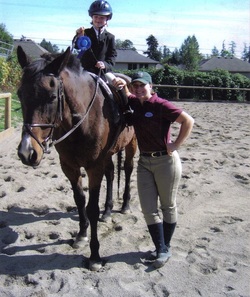Amber Luce
Owner of Pond-a-Luce-a Stables in Federal Way, WA.

Amber Luce with a student. Pondalucea Stables.
Please explain the size of your barn and how many horses live there.
"My barn contains 24 stalls and several pastures. We have about 30 horses that live there now."
Once the stalls are cleaned, where does the manure go and how do you ultimately get rid of it?
"Once we clean the manure out of the stalls, we put it into a big covered cemented area until the “area” bins are full. Once they are full, a gravel/beauty bark company called HiGrade comes to pick it up. And, sometimes during the summer and spring, people will come from all over to load up their trucks and trailers to use the horse manure for their gardens."
When the manure is taken away, where does it go and what is it used for?
"HiGrade takes away the manure and mixes it with dirt. The company turns it into top soil to be sold back into the public."
Do you have to pay to have the manure taken away? If so, is it expensive?
"Yes, we have to pay HiGrade to take the horse manure away. It costs $400 to have the large pile of manure removed once a month."
Luce, Amber. Email. 26 November 2011.
"My barn contains 24 stalls and several pastures. We have about 30 horses that live there now."
Once the stalls are cleaned, where does the manure go and how do you ultimately get rid of it?
"Once we clean the manure out of the stalls, we put it into a big covered cemented area until the “area” bins are full. Once they are full, a gravel/beauty bark company called HiGrade comes to pick it up. And, sometimes during the summer and spring, people will come from all over to load up their trucks and trailers to use the horse manure for their gardens."
When the manure is taken away, where does it go and what is it used for?
"HiGrade takes away the manure and mixes it with dirt. The company turns it into top soil to be sold back into the public."
Do you have to pay to have the manure taken away? If so, is it expensive?
"Yes, we have to pay HiGrade to take the horse manure away. It costs $400 to have the large pile of manure removed once a month."
Luce, Amber. Email. 26 November 2011.
